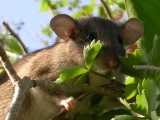Eastern woodrat
The eastern woodrat (Neotoma floridana),[2] is a pack rat native to the central and Eastern United States.[3] Its range extends from the latitude of southeastern New York south to the Gulf of Mexico. It has been recovered as a fossil from late Pleistocene deposits in southeastern New Mexico, several hundred miles southwest of its nearest current range.
Neotoma magister was previously considered to be within N. floridana, but the two are now considered to be separate species.[1]
As with most members of the genus, it feeds opportunistically on nuts, seeds, fungi, buds, stems, roots, foliage, and fruits.[1] In the southern states, it often lives in holes in the ground or hollow trees, constructing large nests.
Predators include black rat snakes and long-tailed weasels.[1]
The eastern woodrat has four clawed digits and a thumb on the front limbs, and five clawed digits on its rear limbs.[3]
References
Notes
Bibliography
- Harris, A. H. 1984. Neotoma in the Late Pleistocene of New Mexico and Chihuahua. Special Publications, Carnegie Museum of Natural History 8:164-178.
- Linzey, A.V., Jordan, R.A. & Hammerson, G. (2008). "Neotoma floridana". IUCN Red List of Threatened Species. Version 2009.2. International Union for Conservation of Nature. Retrieved 4 February 2010.
- Monty, Anne-Marie & Emerson, Robert E. (2003). "Eastern Woodrat". In Feldhamer, George A. et al. Wild mammals of North America: biology, management, and conservation. JHU Press. ISBN 978-0-8018-7416-1.
- Wiley, R. W. 1980. Neotoma floridana. Mammalian Species, No. 139:1-7.
|
|---|
| | | | Baiomyini | |
- Southern Pygmy Mouse (B. musculus)
- Northern Pygmy Mouse (B. taylori)
|
|---|
| |
- Alston's Brown Mouse (S. teguina)
- Chiriqui Brown Mouse (S. xerampelinus)
|
|---|
|
|---|
| | Neotomini | |
- Subgenus Neotoma: White-throated Woodrat (N. albigula)
- Tamaulipan Woodrat (N. angustapalata)
- Bryant's Woodrat (N. bryanti)
- Nicaraguan Woodrat (N. chrysomelas)
- Arizona Woodrat (N. devia)
- Florida Woodrat (N. floridana )
- Goldman's Woodrat (N. goldmani)
- Desert Woodrat (N. lepida )
- White-toothed Woodrat (N. leucodon)
- Big-eared Woodrat (N. macrotis)
- Allegheny Woodrat (N. magister)
- Mexican Woodrat (N. mexicana)
- Southern Plains Woodrat (N. micropus)
- Nelson's Woodrat (N. nelsoni)
- Bolaños Woodrat(N. palatina)
- Stephen's Woodrat (N. stephensi)
- Subgenus Teanopus: Sonoran Woodrat (N. phenax)
- Subgenus Teonoma: Bushy-tailed Woodrat (N. cinerea)
- Dusky-footed Woodrat (N. fuscipes)
|
|---|
| Xenomys |
- Magdalena Rat (X. nelsoni)
|
|---|
| Hodomys |
- Allen's Wood Rat (H. alleni)
|
|---|
| |
- Goldman's Diminutive Woodrat (N. goldmani)
- Diminutive Woodrat (N. neotomodon)
|
|---|
|
|---|
| | Ochrotomyini | |
|---|
| | Reithrodontomyini | |
- californicus group: California Mouse (P. californicus)
- eremicus group: Cactus Mouse (P. eremicus)
- Angel Island Mouse (P. guardia)
- San Lorenzo Mouse (P. interparietalis)
- Dickey's Deer Mouse (P. dickeyi)
- False Canyon Mouse (P. pseudocrinitus)
- Eva's Desert Mouse (P. eva)
- Burt's Deer Mouse (P. caniceps)
- Mesquite Mouse (P. merriami)
- hooperi group: Hooper's Mouse (P. hooperi)
- leucopus group: White-footed Mouse (P. leucopus)
- Cotton Mouse (P. gossypinus)
- aztecus group: Aztec Mouse (P. aztecus)
- Gleaning Mouse (P. spicilegus)
- Winkelmann's Mouse (P. winkelmanni)
- boylii group: Brush Mouse (P. boylii)
- Nimble-Footed Mouse (P. levipes)
- Schmidly's Deer Mouse (P. schmidlyi)
- San Esteban Island Mouse (P. stephani)
- Texas Mouse (P. attwateri)
- Nayarit Mouse (P. simulus)
- Tres Marias Island Mouse (P. madrensis)
- White-Ankled Mouse (P. pectoralis)
- Chihuahuan Mouse (P. polius)
- melanophrys group: Plateau Mouse (P. melanophrys)
- Marsh Mouse (P. perfulvus)
- Puebla Deer Mouse (P. mekisturus)
- furvus group: Blackish Deer Mouse (P. furvus)
- El Carrizo Deer Mouse (P. ochraventer)
- Maya Mouse (P. mayensis)
- mexicanus group: Mexican Deer Mouse (P. mexicanus)
- Naked-Eared Deer Mouse (P. gymnotis)
- Guatemalan Deer Mouse (P. guatemalensis)
- Chiapan Deer Mouse (P. zarhynchus)
- Big Deer Mouse (P. grandis)
- Yucatan Deer Mouse (P. yucatanicus)
- Stirton's Deer Mouse (P. stirtoni)
|
|---|
| |
- Guerrero Harvest Mouse (R. bakeri)
- Short-nosed Harvest Mouse (R. brevirostris)
- Sonoran Harvest Mouse (R. burti)
- Volcano Harvest Mouse (R. chrysopsis)
- Chiriqui Harvest Mouse (R. creper)
- Darien Harvest Mouse (R. darienensis)
- Fulvous Harvest Mouse (R. fulvescens)
- Slender Harvest Mouse (R. gracilis)
- Hairy Harvest Mouse (R. hirsutus)
- Eastern Harvest Mouse (R. humulis)
- Western Harvest Mouse (R. megalotis)
- Mexican Harvest Mouse (R. mexicanus)
- Small-Toothed Harvest Mouse (R. microdon)
- Plains Harvest Mouse (R. montanus)
- R. musseri
- Nicaraguan Harvest Mouse (R. paradoxus)
- Salt Marsh Harvest Mouse (R. raviventris)
- Rodriguez's Harvest Mouse (R. rodriguezi)
- Cozumel Harvest Mouse (R. spectabilis)
- Sumichrast's Harvest Mouse (R. sumichrasti)
- Narrow-Nosed Harvest Mouse (R. tenuirostris)
- Zacatecas Harvest Mouse (R. zacatecae)
|
|---|
| | |
|---|
| Neotomodon |
- Mexican Volcano Mouse (N. alstoni)
|
|---|
| | |
|---|
| |
- Yellow Isthmus Rat (I. flavidus)
- Mount Pirri Isthmus Rat (I. pirrensis)
|
|---|
| |
- Oaxaca Giant Deer Mouse (M. cryophilus)
- Nelson's Giant Deer Mouse (M. nelsoni)
- Thomas's Giant Deer Mouse (M. thomasi)
|
|---|
| |
- Chinanteco Deermouse (H. chinanteco)
- Delicate Deermouse (H. delicatulus)
- Ixtlán Deermouse (H. ixtlani)
- Zempoaltepec deermouse (H. lepturus)
- Crested-tailed Deermouse (H. lophurus)
- H. schmidlyi
- Jico Deermouse (H. simulatus)
|
|---|
| Osgoodomys |
- Michoacan Deer Mouse (O. banderanus)
|
|---|
|
|---|
|

